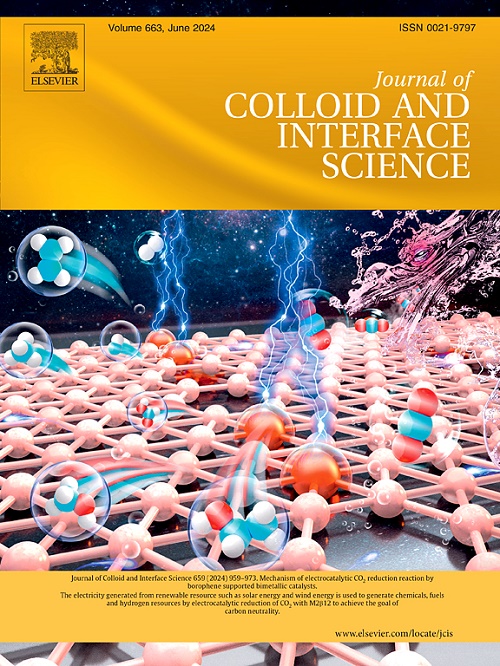Self-assembled hole transport engineering and bio-inspired coordination/incoordination ligands synergizing strategy for productive photoelectrochemical water splitting
IF 9.4
1区 化学
Q1 CHEMISTRY, PHYSICAL
引用次数: 0
Abstract
Charge transport and metal site stability play a critical role on realizing efficient solar water splitting in photoelectrochemical devices. Here, we investigated BiVO4-based composite photoanodes (labelled as NF@PTA/2PACz/BVO) in which BiVO4, [2-(9H-carbazol-9-yl) ethyl] phosphonic acid (2PACz) hole transport layers based on self-assembled monolayers (SAMs), and terephthalic acid (PTA)-functionalized NiFeOOH (NF@PTA) oxygen evolution cocatalysts (OECs) structurally similar to the OECs in natural photosystem II, were assembled sequentially. Alignment of energy levels and stabilization of metal sites can be achieved by this layer-designed structure. And the uncoordinated (![]() COOH) carboxylate groups can accelerate the proton transfer. Fundamental investigations reveal that the NF@PTA/2PACz/BVO photoanode exhibits unique properties including passivated surface traps, excellent carrier density and lifetime, enlarged photovoltage, and smoother hole transport band structure. Consequently, the optimum NF@PTA/2PACz/BVO photoanode shows the photoelectrochemical (PEC) performance of 5.43 mA cm−2 at 1.23 V vs reversible hydrogen electrode with an applied bias photon-to-current efficiency of 1.45 %. The coupled C
COOH) carboxylate groups can accelerate the proton transfer. Fundamental investigations reveal that the NF@PTA/2PACz/BVO photoanode exhibits unique properties including passivated surface traps, excellent carrier density and lifetime, enlarged photovoltage, and smoother hole transport band structure. Consequently, the optimum NF@PTA/2PACz/BVO photoanode shows the photoelectrochemical (PEC) performance of 5.43 mA cm−2 at 1.23 V vs reversible hydrogen electrode with an applied bias photon-to-current efficiency of 1.45 %. The coupled C![]() O
O![]() Fe bond between the coordinating carboxylate and the metals not only inhibits the leaching of the metal species but also maintains a steady photocurrent density over 20 h of stability test. Our work paves the way for the development of more efficient PEC cells with superior charge separation and breakthroughs in the stability of metal active sites, thus broadening their potential applications.
Fe bond between the coordinating carboxylate and the metals not only inhibits the leaching of the metal species but also maintains a steady photocurrent density over 20 h of stability test. Our work paves the way for the development of more efficient PEC cells with superior charge separation and breakthroughs in the stability of metal active sites, thus broadening their potential applications.

自组装空穴传输工程和生物启发配位/不配位配体协同战略,实现高效光电化学水分离。
在光电化学器件中,电荷传输和金属位点稳定性对实现高效太阳能水分离起着至关重要的作用。在这里,我们研究了基于 BiVO4 的复合光阳极(NF@PTA/2PACz/BVO),其中 BiVO4、[2-(9H-咔唑-9-基)乙基]膦酸(2PACz)空穴传输层基于自组装单层(SAM)、和对苯二甲酸(PTA)功能化的 NiFeOOH(NF@PTA)氧进化协同催化剂(OEC),其结构与天然光系统 II 中的 OEC 相似。这种层设计结构可实现能级对齐和金属位点稳定。非配位(COOH)羧酸基团可以加速质子转移。基础研究表明,NF@PTA/2PACz/BVO 光阳极具有独特的性能,包括钝化的表面陷阱、优异的载流子密度和寿命、更高的光电压和更平滑的空穴传输带结构。因此,最佳 NF@PTA/2PACz/BVO 光阳极在 1.23 V 电压下对可逆氢电极的光电化学(PEC)性能为 5.43 mA cm-2,外加偏压光子对电流效率为 1.45%。配位羧酸盐和金属之间的耦合 COFe 键不仅抑制了金属物种的浸出,而且在 20 小时的稳定性测试中保持了稳定的光电流密度。我们的研究工作为开发更高效的 PEC 电池铺平了道路,这种电池具有卓越的电荷分离性能,并在金属活性位点的稳定性方面取得了突破,从而拓宽了其潜在的应用领域。
本文章由计算机程序翻译,如有差异,请以英文原文为准。
求助全文
约1分钟内获得全文
求助全文
来源期刊
CiteScore
16.10
自引率
7.10%
发文量
2568
审稿时长
2 months
期刊介绍:
The Journal of Colloid and Interface Science publishes original research findings on the fundamental principles of colloid and interface science, as well as innovative applications in various fields. The criteria for publication include impact, quality, novelty, and originality.
Emphasis:
The journal emphasizes fundamental scientific innovation within the following categories:
A.Colloidal Materials and Nanomaterials
B.Soft Colloidal and Self-Assembly Systems
C.Adsorption, Catalysis, and Electrochemistry
D.Interfacial Processes, Capillarity, and Wetting
E.Biomaterials and Nanomedicine
F.Energy Conversion and Storage, and Environmental Technologies

 求助内容:
求助内容: 应助结果提醒方式:
应助结果提醒方式:


